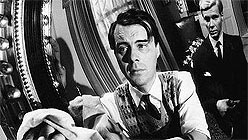Exile does strange things to a film director. Good things, sometimes. You hear a lot about the Europeans — the likes of Billy Wilder, Max Ophuls, Otto Preminger, Douglas Sirk — who blessed us with their presence when the going in Hitler’s hellhole got tough. But what of those occasional Americans who had good cause to skip out for points east?
Joseph Losey is an interesting case. At his best, he had a way with outsiderhood. The Wisconsin-born, ivy-educated director made his way through theater into for-hire work at MGM, then sovereignty at RKO, and eventually — perhaps inevitably — banishment from Hollywood altogether. Why inevitably? Having come up during the Depression, Losey had liked the looks of communism for a time, but maybe it also had something to do with his oft-reported gift for estranging friends.
With an improbably strong remake of Fritz Lang’s masterpiece, M in 1951, Losey showed prescient intuition about the mechanics of alienation and hysteria: The story concerns a compulsive killer of children and, what is evidently worse, the mob madness by which he’s subdued. (It would be a while yet before the cave full of radioactive children in Losey’s These Are the Damned; meanwhile, a few more genre-elevating films with cat-like camera moves and titular variations of the word “prowl.”)
That same year, Losey blew off his HUAC summons, got blacklisted, and skedaddled to England. It turned out to be a productive move — not least due to some highly fruitful recurring collaborations, with actor Dirk Bogarde, playwright Harold Pinter, and jazz composer John Dankworth. Before long Losey had adeptly picked the scab of Britain’s upper crust. The films became more personal and confined, unveiling volatile states of mind through highly controlled environments. They were peppered with pervy power games and vehement little class-war duets. Probably the pinnacle of Losey’s artful sadism is the Pinter-scripted Bogarde showcase The Servant of 1963, but it still depends who you ask.
Losey’s subsequent ventures into arty ’60s chic and parodies thereof would become historic head-scratchers. The comic-book-based spy-thriller spoof Modesty Blaise (1966), with Bogarde, Monica Vitti, and Terence Stamp, has been widely reviled, but John Waters adores it. And what about Liz Taylor and Richard Burton doing Tennessee Williams — was Losey absolutely the wrong director for such a thing, or does his presence tip it over into something somehow appallingly right? It’s not called Boom! (1968) for nothing.


